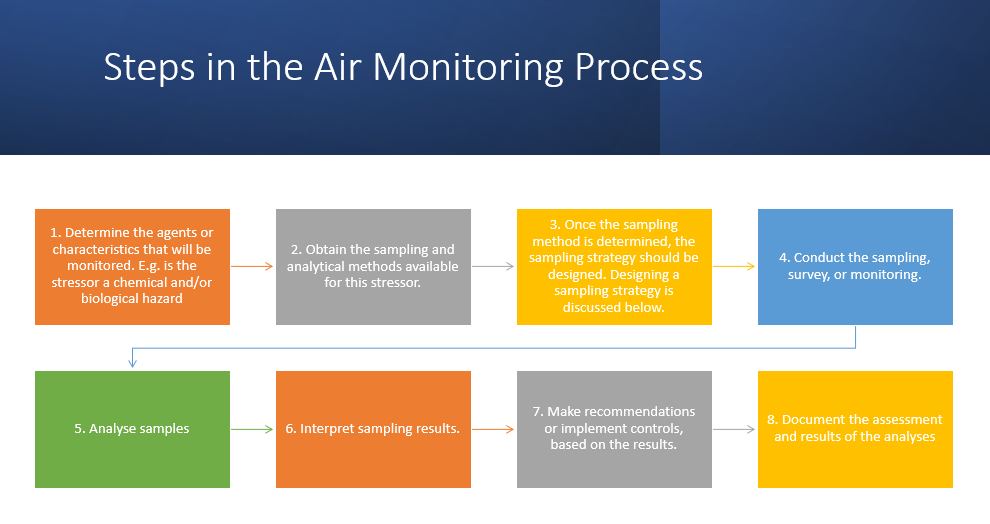Monitoring environmental conditions in the workplace is an important tool in assessing potential hazards or exposures to various chemical compounds, biological agents and physical parameters.
Air sampling is the process of capturing some aspect of the air or a portion of the environment. The environment can be either an outdoor area or a smaller enclosed space.
There are a number of reasons to conduct air sampling or air monitoring. The overriding reason to monitor and conduct assessments is to evaluate the potential hazards in the workplace air as part of a comprehensive health and safety programme. Based on the specifics of the environment, monitoring might include assessing exposure to chemical compounds, biological agents (such as fungi or moulds, anthrax (a highly infectious, often fatal, bacterial disease of mammals, especially cattle and sheep, that is transmissible to humans and causes skin ulcers), or dust mites or physical characteristics of the environment (such as temperature, humidity or airflow). These various chemical compounds, biological agents or physical characteristics will be referred to in this guide as "agents or characteristics."
The primary reasons to monitor are:
- Evaluate compliance with regulations and laws
- Estimate exposure for the protection of staff
- Estimate exposure for the protection of the public
- Estimate concentration for protection of collections, objects
- Estimate the effectiveness of ventilation or other contaminant controls
The decision to monitor can be based on a number of issues, including those listed above, and may take other reasons or factors into account. If there is a reasonable chance that conditions or concentrations will exceed occupational exposure levels—such as the Permissible Exposure Level (PEL) published by the Occupational Safety and Health Administration (OSHA)—there is an obligation under the OSHA regulation to evaluate the conditions, and this is routinely done by monitoring the air.
A workplace evaluation normally begins with a close look at the operations, especially the materials or products used in the immediate workplace, adjacent areas and the immediately surrounding area. This evaluation may include a review of processes, equipment used, chemicals or products used (which often calls for a review of safety data sheets or SDSs), and other factors affecting the workplace environment.
The evaluation could consist of the following steps:

Click here to view a video that explains air sampling.
Where the inhalation of an HCA is concerned, an employer contemplated in regulation 5(4) must ensure that the measurement meme of the airborne concentrations of the HCA to which an employee is exposed, is:
- Carried out in accordance with the provisions of these regulations;
- Carried out only after the relevant health and safety representative or relevant health and safety committee has been informed thereof and given a reasonable opportunity to comment thereon;
- Carried out by an approved inspection authority; and
- Representative of the exposure of an employee to the airborne HCA in accordance with the provisions of sub-regulation (2).
In order to comply with the provisions of sub-regulation (1)(d), an employer must:
- Ensure that the measurement programme, in the case of a group measurement, makes provision for the selection of the number of persons for a sample to be done as contemplated in Chapters 3 and 4 and Technical Appendix A of the OESSM: Provided that such sample size must be chosen for the top 10% of the group at the 95% confidence level for an HCA with a control limit, and for the top 10% of the group at the 90% confidence level for an HCA with a recommended limit; and
- Subject to the criteria contained in regulation 6(1), carry out representative measurements at least every 24 months for an HCA with an OEL-ML or an OEL-RL as listed in Table 2 or 3 of Annexure 2.